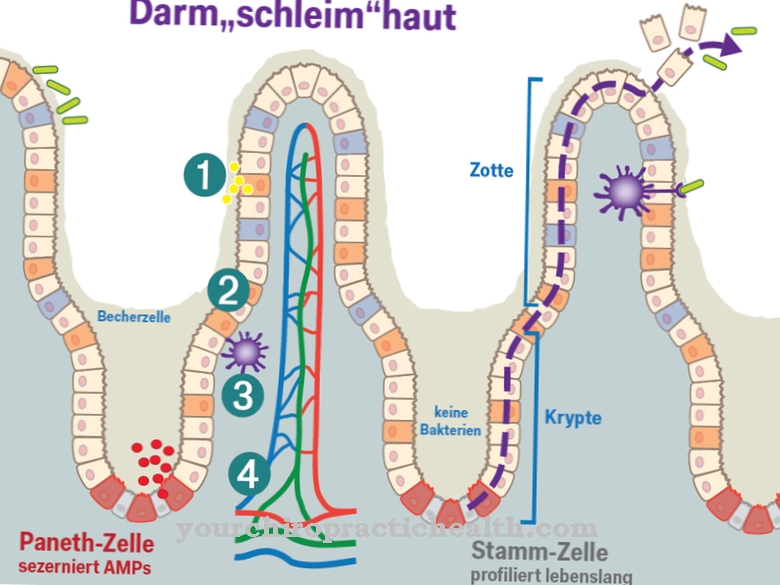The Sigmoid colon is the last section of the colon and is just in front of the rectum. It is mainly responsible for the final digestion and portioning of the digestive residues before they enter the rectum.
What is the Sigmoid Colon?
The fourth and last section of the large intestine (colon) is called the sigmoid colon. It's close to the basin. The name Colon sigmoideum developed from the Greek and describes the appearance of this section of the intestine. It has a shape similar to the Greek lowercase letter sigma, which is the forerunner of the Latin S. This section of the intestine is then also simplified as Sigma designated.
As part of the large intestine, the sigma is mainly responsible for further digesting and proportioning the last digestive residues before they are excreted as faeces via the rectum. However, due to its anatomical features, the sigmoid colon is also susceptible to certain intestinal diseases such as diverticulitis, diverticulosis or colon cancer.
Anatomy & structure
The sigmoid colon is an inseparable part of the large intestine (colon). So the colon is divided into four sections. The first section is called the ascending colon (ascending colon) because of its ascending course on the right side of the abdomen. Then comes the transverse colon (colon transversum). The third section of the large intestine is the descending colon (colon). This is then followed by the sigmoid colon, which finally goes into the rectum or Rectum opens. The course of the bowel of the sigma looks like an inverted S-curve. Starting from the descending colon, the sigma rises again slightly in the vicinity of the left ilium before it flows downwards into the rectum in a twisted curve.
The sigmoid colon always runs within the peritoneum. Its upper third is attached to the back peritoneum with delicate adhesions. The sigma does not have a uniform length. The sigmoid colon is supplied by the arteriae sigmoideae, which originate from the arteria mesenterica inferior (lower intestinal artery). The arteriae sigmoideae (sigmoid arteries) are arteries that supply the sigmoid with fresh blood. Within the so-called mesentery, however, there are cross-connections between the sigma and other intestinal sections, so that its blood supply can also be guaranteed when the sigmoid arteries are blocked. Full bowel function can be restored even after the sigmoid colon has been surgically removed.
Function & tasks
The sigmoid colon is responsible for further digesting and proportioning digestive residues before they enter the rectum for excretion. In the rectum, water is then withdrawn from the remaining residues until they are excreted as faeces via the anus. The processes that take place in the sigma are similar to the processes that take place in the entire colon. The main task of the large intestine is to further thicken the intestinal contents by removing water. The digestion of the porridge entering from the small intestine is also continued. A large number of intestinal bacteria are available for this. On the one hand, these bacteria benefit from the nutritional content of the chyme. On the other hand, they also supply the organism with valuable vitamins, such as vitamin K. A vital symbiosis has developed between host and bacteria.
These processes take place similarly in all sections of the large intestine, whereby the chyme has thickened considerably towards the sigma. However, the length of the colon contributes to the fact that the digestive residues can still be used effectively for the body. This applies both to valuable nutrients and to the recovery of important electrolytes and water. During the passage through the large intestine, approx. 1.5 liters of water are withdrawn from the chyme. The special feature of the function of the sigma, however, is that in addition to the further digestive process, it controls the release of food residues into the rectum through proportioning. Only after the rectum has been emptied do further digestive residues move back from the sigmoid colon.
Diseases
The sigmoid colon, the last section of the large intestine, is subject to high pressure due to increased muscle tension. This makes the S-shaped part of the bowel appear narrower and more spastic than other sections of the bowel. Due to the pressure, there are often bulges in the intestine, which are referred to as diverticula. Feces can collect in these diverticula, which can lead to their inflammation. The inflammation of diverticula is known as diverticulitis. Due to a low-fiber diet, this disease has become very common in industrialized countries.
Diverticulitis manifests itself as pain in the left upper abdomen, which often radiates to the back. Furthermore, fever, nausea and vomiting occur. In extreme cases, life-threatening complications such as peritonitis can also occur. Diverticulitis is treated with antibiotics and, in severe cases, surgery. Another disease of the sigmoid colon is diverticulosis. In diverticulosis, in contrast to diverticula, only the intestinal mucosa is everted.
The diagnosis of this disease is often made only by chance, as there are usually no symptoms. However, diverticulitis can also occur here as a complication. In colon cancer, the sigmoid colon is most commonly affected, along with the rectum. Colorectal cancer develops particularly when the digestive remains in the intestine for too long. Another disease specific to the colon is the chronic autoimmune disease ulcerative colitis, which progresses in constant attacks. However, there are also a number of intestinal diseases that affect all other intestinal sections in addition to the sigmoid colon.
You can find your medication here
➔ Medicines for stomach ailments and painTypical & common colon diseases
- Diverticulum in the intestine (diverticulosis)
- Intestinal colic
- Appendicitis
- Colon cancer













.jpg)

.jpg)
.jpg)











.jpg)